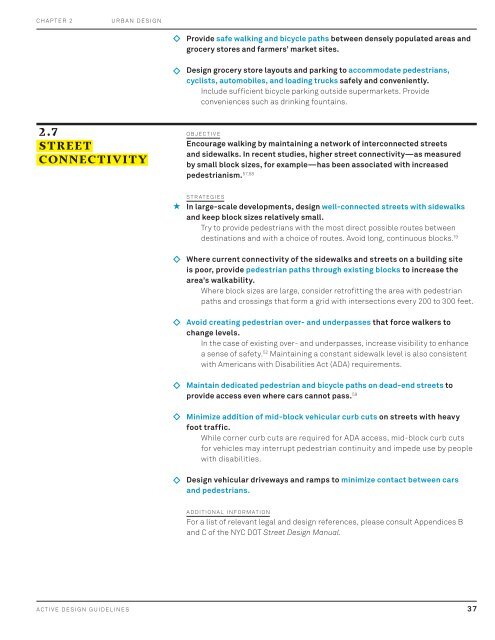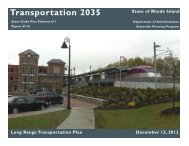Active Design Guidelines: Promoting Physical Activity and Health in ...
Active Design Guidelines: Promoting Physical Activity and Health in ...
Active Design Guidelines: Promoting Physical Activity and Health in ...
Create successful ePaper yourself
Turn your PDF publications into a flip-book with our unique Google optimized e-Paper software.
chapter 2urban designProvide safe walk<strong>in</strong>g <strong>and</strong> bicycle paths between densely populated areas <strong>and</strong>grocery stores <strong>and</strong> farmers’ market sites.<strong>Design</strong> grocery store layouts <strong>and</strong> park<strong>in</strong>g to accommodate pedestrians,cyclists, automobiles, <strong>and</strong> load<strong>in</strong>g trucks safely <strong>and</strong> conveniently.Include sufficient bicycle park<strong>in</strong>g outside supermarkets. Provideconveniences such as dr<strong>in</strong>k<strong>in</strong>g founta<strong>in</strong>s.2.7STREETCONNECTIVITYo b j e c t i v eEncourage walk<strong>in</strong>g by ma<strong>in</strong>ta<strong>in</strong><strong>in</strong>g a network of <strong>in</strong>terconnected streets<strong>and</strong> sidewalks. In recent studies, higher street connectivity—as measuredby small block sizes, for example—has been associated with <strong>in</strong>creasedpedestrianism. 57,58s t r a t e g i e sIn large-scale developments, design well-connected streets with sidewalks<strong>and</strong> keep block sizes relatively small.Try to provide pedestrians with the most direct possible routes betweendest<strong>in</strong>ations <strong>and</strong> with a choice of routes. Avoid long, cont<strong>in</strong>uous blocks. 19Where current connectivity of the sidewalks <strong>and</strong> streets on a build<strong>in</strong>g siteis poor, provide pedestrian paths through exist<strong>in</strong>g blocks to <strong>in</strong>crease thearea’s walkability.Where block sizes are large, consider retrofitt<strong>in</strong>g the area with pedestrianpaths <strong>and</strong> cross<strong>in</strong>gs that form a grid with <strong>in</strong>tersections every 200 to 300 feet.Avoid creat<strong>in</strong>g pedestrian over- <strong>and</strong> underpasses that force walkers tochange levels.In the case of exist<strong>in</strong>g over- <strong>and</strong> underpasses, <strong>in</strong>crease visibility to enhancea sense of safety. 52 Ma<strong>in</strong>ta<strong>in</strong><strong>in</strong>g a constant sidewalk level is also consistentwith Americans with Disabilities Act (ADA) requirements.Ma<strong>in</strong>ta<strong>in</strong> dedicated pedestrian <strong>and</strong> bicycle paths on dead-end streets toprovide access even where cars cannot pass. 59M<strong>in</strong>imize addition of mid-block vehicular curb cuts on streets with heavyfoot traffic.While corner curb cuts are required for ADA access, mid-block curb cutsfor vehicles may <strong>in</strong>terrupt pedestrian cont<strong>in</strong>uity <strong>and</strong> impede use by peoplewith disabilities.<strong>Design</strong> vehicular driveways <strong>and</strong> ramps to m<strong>in</strong>imize contact between cars<strong>and</strong> pedestrians.a d d i t i o n a l i n f o r m a t i o nFor a list of relevant legal <strong>and</strong> design references, please consult Appendices B<strong>and</strong> C of the NYC DOT Street <strong>Design</strong> Manual.active design guidel<strong>in</strong>es 37
















